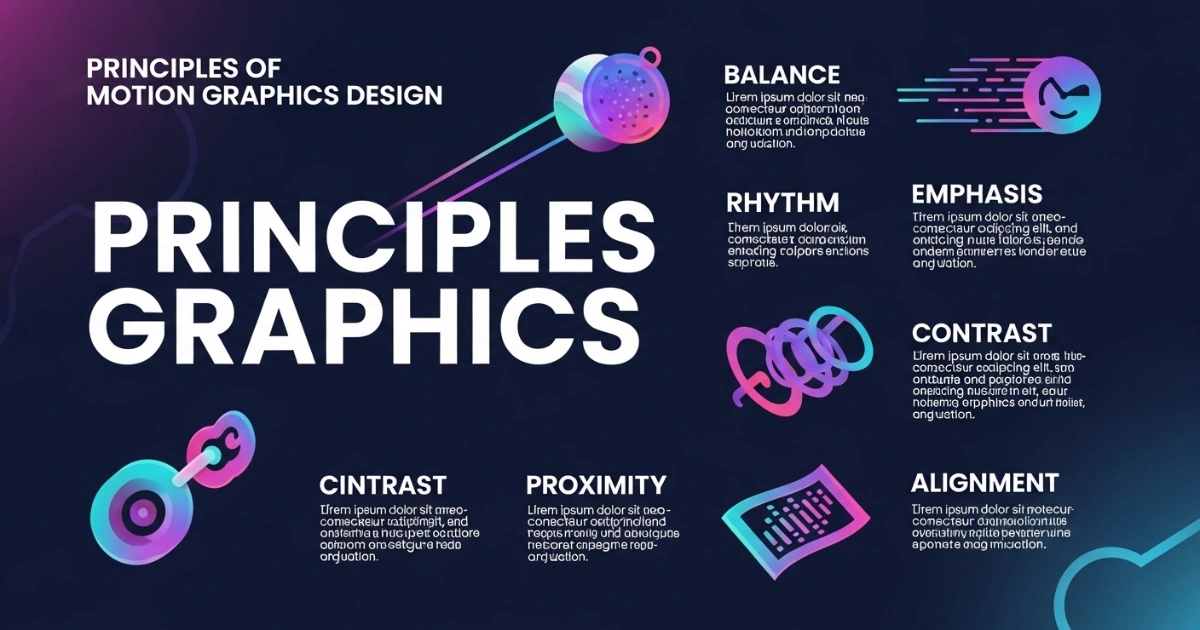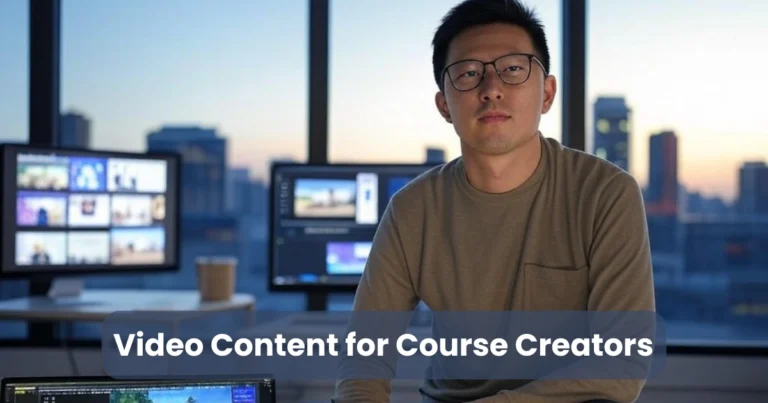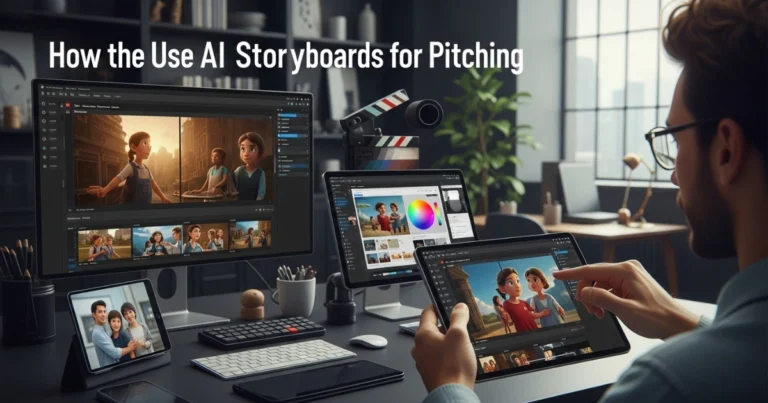Principles of Motion Graphics Design: A Comprehensive Guide

Contents
- 1 What Are Motion Graphics?
- 2 Core Principles of Motion Graphics Design
- 2.1 1. Timing and Spacing
- 2.2 2. Hierarchy and Emphasis
- 2.3 3. Anticipation and Follow-Through
- 2.4 4. Staging and Composition
- 2.5 5. Contrast and Color
- 2.6 6. Simplicity and Clarity
- 2.7 7. Storytelling and Emotional Impact
- 2.8 8. Consistency and Branding
- 2.9 9. Sound and Synchronization
- 2.10 10. Iteration and Feedback
- 3 Practical Tips for Applying Motion Graphics Principles
- 4 Common Mistakes to Avoid
- 5 Tools and Resources for Motion Graphics Design
Motion graphics design is a dynamic field that blends creativity with technical skill to produce visually captivating animations. By mastering the principles of motion graphics design, you can craft animations that engage audiences, convey messages effectively, and enhance storytelling. This article explores the foundational principles that drive successful motion graphics, offering practical insights for designers aiming to elevate their work. Whether you’re a beginner or a seasoned professional, understanding these principles will help you create animations that stand out in today’s fast-paced digital landscape. Let’s dive into the essential concepts that make motion graphics both functional and aesthetically pleasing.
What Are Motion Graphics?
Before exploring the principles of motion graphics design, it’s crucial to understand what motion graphics are. Motion graphics combine graphic design, animation, and multimedia elements to create moving visuals, often used in videos, advertisements, social media, and user interfaces. Unlike traditional animation, which focuses on character-driven narratives, motion graphics emphasize visual storytelling through shapes, text, and abstract elements. They’re widely used in branding, explainer videos, and digital marketing to communicate ideas quickly and effectively.
Motion graphics require a balance of creativity and technical precision. Designers use software like Adobe After Effects, Cinema 4D, or Blender to bring static visuals to life. By applying the principles of motion graphics design, you ensure your animations are not only visually appealing but also purposeful and engaging. Now, let’s explore the core principles that guide this creative process.
Core Principles of Motion Graphics Design

1. Timing and Spacing
Timing and spacing are foundational principles of motion graphics design that dictate how animations feel and flow. They refers to the speed and duration of an object’s movement, while spacing determines how that movement appears on screen. Together, they create a sense of rhythm and realism. For instance, a fast-moving object with tight spacing feels energetic, while slow timing with wider spacing conveys calmness.
To maximize timing, use easing techniques to make movements feel natural. Easing allows animations to accelerate or decelerate smoothly, mimicking real-world physics. For example, when a ball bounces, it moves faster at the start and slows as it reaches its peak. Tools like After Effects’ Graph Editor let you fine-tune easing curves for precise control. By mastering timing and spacing, you ensure your animations feel dynamic and intentional.
2. Hierarchy and Emphasis
Visual hierarchy guides the viewer’s eye to the most important elements in a motion graphic. This principle ensures that key messages stand out, even in complex animations. To establish hierarchy, use size, color, contrast, and motion. For example, a bold, animated title in a vibrant color naturally draws attention before smaller, subtler elements.
To create emphasis, animate elements sequentially. For instance, in an explainer video, animate the main text first, followed by supporting visuals. This directs the viewer’s focus and enhances comprehension. Additionally, use negative space to avoid clutter, ensuring your design remains clean and impactful. By prioritizing hierarchy, you make your motion graphics both engaging and easy to follow.
3. Anticipation and Follow-Through
Anticipation and follow-through add realism and polish to animations. These prepares the viewer for an action, such as a character leaning back before jumping. Follow-through, on the other hand, shows the aftermath of an action, like a swinging pendulum slowing to a stop. These principles of motion graphics design make movements feel organic and believable.
For example, in a logo animation, a slight scale-up before the logo settles into place creates anticipation. Similarly, a subtle overshoot when elements come to rest adds follow-through. These techniques prevent animations from feeling abrupt, enhancing their professional quality. Practice these principles to give your motion graphics a lifelike, polished feel.
4. Staging and Composition
Staging involves arranging elements in a scene to tell a story effectively. In motion graphics design, strong composition ensures clarity and visual appeal. Use the rule of thirds to place key elements off-center, creating balance and interest. Additionally, consider depth by layering elements in the foreground, midground, and background.
For instance, in a promotional video, position the product prominently while animating background elements subtly to avoid distraction. Use consistent lighting and color schemes to unify the composition. By carefully staging your scenes, you guide the viewer’s attention and create a cohesive visual narrative.
5. Contrast and Color
Contrast and color are powerful tools in motion graphics design. Color creates visual interest by juxtaposing light and dark elements, large and small shapes, or fast and slow movements. For example, a bright logo against a dark background instantly grabs attention. Similarly, contrasting motion speeds—such as a slow zoom paired with a quick text reveal—adds dynamism.
Color, meanwhile, evokes emotion and reinforces branding. Use color theory to choose harmonious palettes, such as complementary or analogous colors. Tools like Adobe Color can help you create balanced schemes. Additionally, ensure accessibility by maintaining sufficient contrast for text readability. By leveraging contrast and color, you make your motion graphics visually striking and memorable.
6. Simplicity and Clarity
In motion graphics design, less is often more. Simplicity ensures your animations remain clear and focused, avoiding overwhelming the viewer. Stick to a limited color palette, minimal text, and clean layouts. For example, an explainer video with concise text and simple shapes communicates faster than a cluttered design.
To maintain clarity, align animations with the project’s goals. If the goal is to explain a product, prioritize key features over decorative flourishes. Test your designs with others to ensure the message is clear. By embracing simplicity, you create motion graphics that are both professional and effective.
7. Storytelling and Emotional Impact
Great motion graphics tell a story, even in short formats. Storytelling engages audiences by creating an emotional connection. To incorporate storytelling, start with a clear narrative arc: introduce the concept, build interest, and deliver a resolution. For example, a brand animation might start with a problem, show the product as a solution, and end with a call to action.
To maximize emotional impact, align visuals, motion, and sound. A swelling soundtrack paired with smooth animations can evoke excitement, while muted colors and slow transitions create calmness. By weaving storytelling into your motion graphics, you make them resonate with viewers on a deeper level.
8. Consistency and Branding
Consistency ties motion graphics to a brand’s identity. Use consistent fonts, colors, and motion styles to reinforce brand recognition. For example, a tech company might use sleek, futuristic animations, while a playful brand might opt for bouncy, colorful transitions.
To ensure consistency, create a style guide before starting a project. Define the color palette, typography, and animation principles. This approach saves time and ensures all elements align with the brand’s vision. By maintaining consistency, you create motion graphics that feel cohesive and professional.
9. Sound and Synchronization
Sound enhances motion graphics by adding rhythm and emotion. In motion graphics design, synchronize animations with audio cues for maximum impact. For example, a text reveal timed to a sound effect creates a satisfying “pop.” Similarly, background music can set the tone, whether it’s upbeat for a commercial or calming for a corporate video.
When adding sound, ensure it complements the visuals without overpowering them. Use royalty-free audio libraries like Epidemic Sound or AudioJungle to find high-quality tracks. By syncing animations with sound, you create a multisensory experience that captivates viewers.
10. Iteration and Feedback
Iteration is a critical principle of motion graphics design. No animation is perfect on the first try. Create rough drafts, test them, and refine based on feedback. For example, share a draft with clients or colleagues to identify pacing issues or unclear elements.
Use feedback to improve timing, hierarchy, or storytelling. Tools like Frame.io allow for collaborative reviews, streamlining the process. By iterating, you polish your motion graphics and ensure they meet the project’s goals.
Practical Tips for Applying Motion Graphics Principles
To bring these principles to life, follow these actionable tips:

- Plan with Storyboards: Sketch your animation sequence before starting. Storyboards help you visualize timing, hierarchy, and staging.
- Use Templates Wisely: Platforms like Envato Elements offer motion graphics templates. Customize them to align with your brand and principles.
- Learn Software Shortcuts: Master tools like After Effects to streamline your workflow. Shortcuts for easing, keyframing, and layering save time.
- Test Across Devices: Ensure your motion graphics look great on desktops, tablets, and smartphones. Optimize file sizes for faster loading.
- Stay Updated: Follow trends on platforms like Dribbble or Behance to keep your designs fresh and relevant.
By applying these tips, you can effectively implement the principles of motion graphics design in your projects.
Common Mistakes to Avoid
Even experienced designers make mistakes. Here are common pitfalls and how to avoid them:
- Overloading Animations: Too many effects can overwhelm viewers. Stick to simple, purposeful animations.
- Ignoring Timing: Abrupt movements feel unnatural. Use easing and anticipation for smooth transitions.
- Neglecting Branding: Inconsistent colors or fonts weaken brand identity. Always refer to a style guide.
- Skipping Feedback: Failing to test animations can lead to unclear messages. Seek input early and often.
By avoiding these mistakes, you ensure your motion graphics are polished and effective.
Tools and Resources for Motion Graphics Design
To master the principles of motion graphics design, leverage these tools and resources:

- Adobe After Effects: Industry-standard software for creating motion graphics.
- Cinema 4D: Ideal for 3D motion graphics and complex animations.
- Blender: A free, open-source tool for 2D and 3D animation.
- Online Courses: Platforms like Skillshare and Udemy offer motion graphics tutorials.
- Inspiration Platforms: Browse Dribbble, Behance, and Vimeo for creative ideas.
These tools and resources empower you to apply the principles effectively and grow as a designer.
Conclusion
Mastering the principles of motion graphics design unlocks the potential to create animations that captivate and communicate. By focusing on timing, hierarchy, anticipation, staging, contrast, simplicity, storytelling, consistency, sound, and iteration, you can craft visuals that leave a lasting impact. Whether you’re designing for branding, marketing, or entertainment, these principles guide you toward professional, engaging results. Start applying these concepts today, experiment with tools like After Effects, and seek feedback to refine your skills. With practice, you’ll create motion graphics that not only look stunning but also tell compelling stories.






